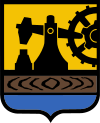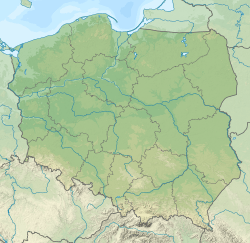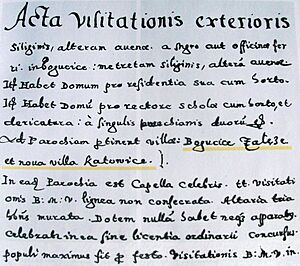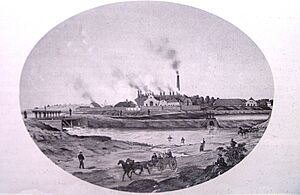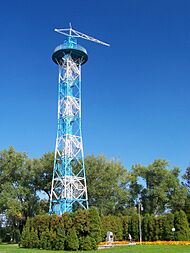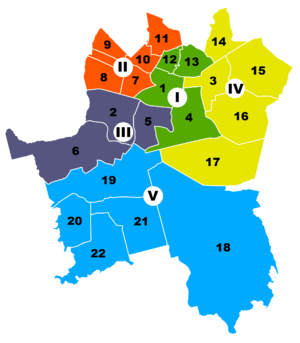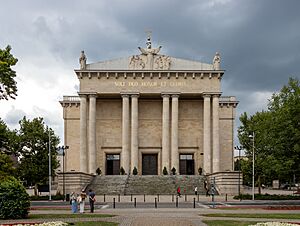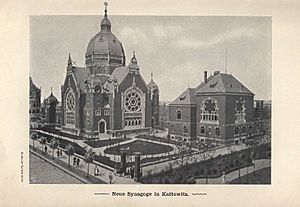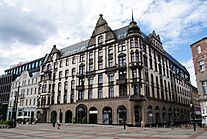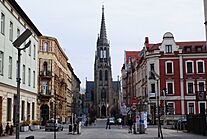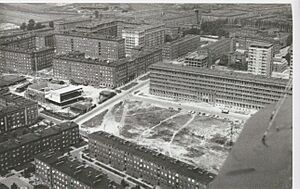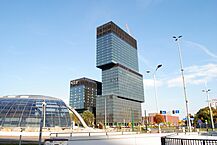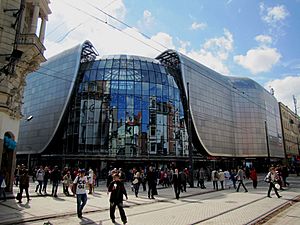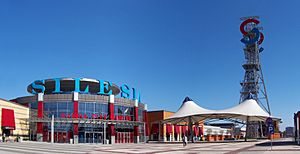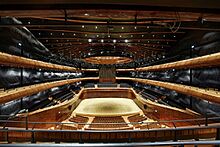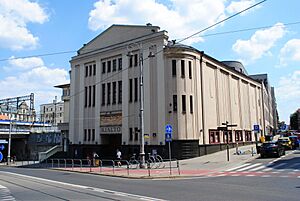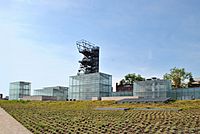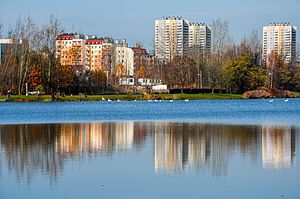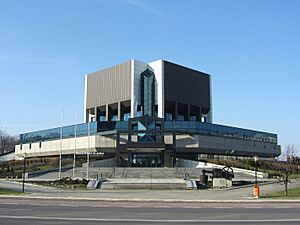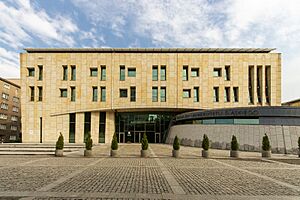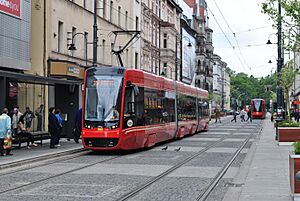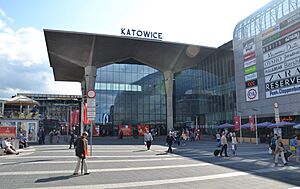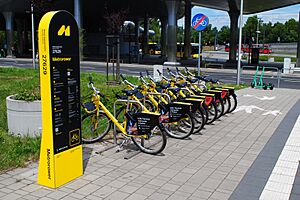Katowice facts for kids
Quick facts for kids
Katowice
|
|||||
|---|---|---|---|---|---|
|
Spodek multipurpose arena
Silesian Parliament
Monopol Hotel
Mariacka Street
3 Maja Street
Market Square
Polish National Radio Symphony Orchestra
KTW
International Congress Centre
Global Office Park
|
|||||
|
|||||
| Motto(s):
for a change
|
|||||
| Country | |||||
| Voivodeship | |||||
| County | city county | ||||
| Established | 16th century – 1598 first official information | ||||
| City rights | 1865 | ||||
| Area | |||||
| • City | 164.64 km2 (63.57 sq mi) | ||||
| • Urban | 2,554 km2 (986 sq mi) | ||||
| • Metro | 5,400 km2 (2,100 sq mi) | ||||
| Highest elevation | 352 m (1,155 ft) | ||||
| Lowest elevation | 266 m (873 ft) | ||||
| Population
(31 December 2021)
|
|||||
| • City | 286,960 |
||||
| • Density | 1,780/km2 (4,600/sq mi) | ||||
| • Urban | 2,710,397 | ||||
| • Metro | 5,294,000 | ||||
| GDP | |||||
| • Urban | €44.570 billion (2021) | ||||
| Time zone | UTC+01:00 (CET) | ||||
| • Summer (DST) | UTC+02:00 (CEST) | ||||
| Postal code |
40-001 to 40–999
|
||||
| Area code(s) | +48 32 | ||||
| Vehicle registration | [[Vehicle registration plates of Poland|]] | ||||
Katowice is a major city in southern Poland. It is the capital of the Silesian Voivodeship (a region in Poland). In 2021, about 287,000 people lived there. Katowice is part of a larger urban area called Metropolis GZM, which has about 2.3 million people. It's also part of an even bigger area that includes parts of the Czech Republic, with around 5 million people. This makes it one of the largest city areas in the European Union.
Katowice started as a small village in the 1500s. Many of its modern parts were villages even earlier, in the Middle Ages. The city grew a lot in the 1700s when people found large amounts of coal nearby. In the 1800s, the Industrial Revolution changed the area. Small farms became big factories, mines, and workshops.
Today, Katowice has changed its focus. It used to be known for heavy industries like coal mining. Now, it's more about services, education, and healthcare. The wider city area is one of the strongest economies in the European Union. Katowice is also a "Global City," meaning it's important for trade, business, transport, and culture in southern Poland. It hosts major events like the Intel Extreme Masters esports tournament. The city is also home to important schools like the University of Silesia. In 2015, UNESCO named Katowice a City of Music.
Contents
History of Katowice
How Katowice Grew
The area around Katowice has been settled for a very long time. The name Katowice first appeared in writing in 1598. However, some villages that are now part of Katowice are much older. For example, the village of Dąb was mentioned in 1299. People in the area mostly farmed and worked in small mills.
Over the centuries, different rulers controlled this region. It was part of Poland, then Bohemia (a kingdom in the Holy Roman Empire), and later Austria. In 1742, it became part of Prussia. The wars that followed caused a lot of damage and reduced the population. In 1838, a man named Franz von Winckler bought Katowice and made it his main base.
Becoming an Industrial City
A new railway line opened in 1847, connecting Katowice to other big cities. This helped the city's economy and population grow quickly. Katowice officially became a city in 1865, thanks to the Prussian king.
The city became very rich because of its large coal and mineral deposits. Coal mining and steel production boomed during the Industrial Revolution. Many Germans, Poles, and Jews lived in the city. In 1884, an important meeting for the Zionist movement took place here. Katowice grew into a major center for coal and steel companies. New services also appeared, like a post office, schools, and a court.
After World War I, the area held a vote to decide if it would join Germany or Poland. Even though Katowice itself voted to stay with Germany, the larger region voted for Poland. So, in 1922, Katowice became part of the new Second Polish Republic. It had some special self-governing powers. In 1924, nearby villages joined Katowice, making the city much bigger. The number of Polish residents grew, and by 1939, Poles made up 93% of the population.
World War II and Beyond
During World War II, German forces invaded Poland in 1939. Katowice was defended by local Poles. Sadly, many Polish defenders were killed. The Germans destroyed many important buildings, including the Great Katowice Synagogue. They changed street names and banned the use of the Polish language. Many Poles and Jews were forced to leave the city. The Germans also set up forced labor camps in the area.
In January 1945, the Soviet army captured Katowice. Unlike some other Polish cities, much of Katowice's city center was saved from destruction.
Post-War Growth and Changes
After the war, Katowice became a major industrial center again. The city grew very fast, with many people moving there. For a short time, from 1953 to 1956, Katowice was called Stalinogród (Stalin's City). This was to honor Joseph Stalin, the leader of the Soviet Union. However, the people of Katowice did not like this name, and the city's original name was brought back in 1956.
In the following years, Katowice became an important place for culture and education. The University of Silesia in Katowice was founded in 1968. Many new buildings were constructed, including the famous Spodek arena in 1971. These buildings became well-known symbols of the city.
A sad event happened on December 16, 1981. Nine protesters were killed at the Wujek Coal Mine. They were protesting against new strict rules imposed by the government. A memorial was later built to remember them.
In 1990, Katowice held its first democratic local elections. The city's economy began to change from heavy industry to modern services.
Katowice in the 21st Century
Today, Katowice is a popular place for business. It has good transport links and many modern office buildings. The Katowice Expo Centre hosts many trade fairs. In 2018, the city hosted a big international meeting about climate change (COP24). In 2022, it hosted the World Urban Forum, a major conference about city development.
Geography and Climate
Where is Katowice?
Katowice covers an area of about 165 square kilometers (64 square miles). It is located in the Silesian Highlands, about 50 kilometers (31 miles) north of the Carpathian Mountains. Two rivers, the Kłodnica and the Rawa, flow through the city. Katowice is one of the highest major cities in Poland, with an average height of 266 meters (873 feet) above sea level.
Katowice's Weather
Katowice has a moderate climate. The average temperature is about 8.2 degrees Celsius (46.8 degrees Fahrenheit). In January, it can be around -2.0 °C (28.4 °F), and in July, it can reach 17.9 °C (64.2 °F). The city gets about 653 millimeters (25.7 inches) of rain each year. Gentle winds usually blow from the southwest.
City Neighborhoods
Katowice has 22 official neighborhoods. The central areas, like Śródmieście and Koszutka, are busy. They have most of the city's cultural places, schools, businesses, and government buildings.
Many northern and eastern neighborhoods grew around old industries like coal mines. These areas often have their own shopping streets and apartment buildings. Nikiszowiec, a former mining town, has become a popular tourist spot because of its unique buildings and art.
Western and southern neighborhoods are more like suburbs. They are home to many middle and upper-middle-class families.
The Katowice Metropolitan Area
Katowice is at the center of the largest group of cities in Poland. This area has about 2.7 million people. The wider Katowice metropolitan area includes about 40 nearby cities and towns. It stretches into the Czech Republic and has over 5 million people.
In 2006, Katowice and 14 other cities formed the Metropolitan Association of Upper Silesia. This group later became the Metropolis GZM. The cities in this area grew because of mining and heavy industry. This led to a unique city look, with red brick houses for workers and factory chimneys. Now, many coal mines and factories have closed. So, the area is focusing on services, offices, shopping, and tourism.
Population and People
Who Lives in Katowice?
In 2020, Katowice had about 293,000 residents. There were more females than males. The population has changed over time. It grew very fast until 1988, reaching over 368,000 people. Since then, the number of people has decreased. This is partly because heavy industries declined and some people moved away.
Before World War II, Katowice had many Poles and Germans. After the war, most Germans left. Many Poles from other parts of Poland moved to Katowice.
Different Backgrounds
Katowice is a diverse city. In 2021, most residents (93.87%) said they were Polish. The largest minority group was Silesians (17.8%). There are also smaller groups of Germans, Ukrainians, and others.
Many immigrants also live in Katowice. In 2021, over 26,000 foreigners had special work permits, mostly from Ukraine. After the 2022 conflict in Ukraine, over 11,500 refugees settled in Katowice.
Education and Jobs
Many people in Katowice have a good education. In 2021, over 32% of adults had a college degree. The region around Katowice has one of the highest rates of people who finished high school in Europe.
In 2022, Katowice had the third-highest average salaries in Poland, after Warsaw and Kraków. The city's job market is strong, with a very low unemployment rate of 1.8% in June 2022.
Religion in Katowice
The main religion in Katowice is Roman Catholicism. In 2021, about 60.5% of residents said they were Roman Catholic. Katowice is home to the main Roman Catholic Archdiocese for the region. The Cathedral of Christ the King is the largest cathedral in Poland.
There are also other Christian groups, like Lutherans. Historically, many Lutherans in Katowice were German. After World War II, their numbers decreased. Other groups include Seventh-day Adventists, Baptists, and Pentecostals.
Judaism has been present in Katowice since at least 1702. The first synagogue was built in 1862. The large Great Synagogue opened in 1900 but was destroyed by the Germans in 1939. Today, there is a Jewish community in Katowice with about 200 members.
Other religions, like Buddhism and Islam, also have followers in the city. Jehovah's Witnesses have several meeting places.
Architecture and Design
City Center Buildings
Unlike many old Polish cities, Katowice did not start as a medieval town. So, it doesn't have a typical old town square. Its design comes from different towns and industrial areas joining together. Most of the city center was built in the late 1800s and early 1900s. At that time, it was part of Prussia. So, the buildings look similar to those in other Prussian cities. They often feature styles like Renaissance and Baroque Revival.
Buildings from Between the World Wars
In 1922, Katowice became part of Poland again. This led to a huge building boom. New buildings were designed in modern styles like functionalist and Bauhaus. The city needed new government buildings and homes. It expanded southward, creating many modern buildings.
The impressive Silesian Parliament building (1923–1929) is a key example. The nearby Cathedral of Christ the King (1927–1955) is also from this time. A famous building from this period is Drapacz Chmur (The Skyscraper). It was one of the first skyscrapers in Poland and used a steel frame.
Post-War Buildings
After World War II, Katowice grew quickly again. New buildings were often in the socrealist style at first. Later, architects used ideas from Le Corbusier, a famous architect. They designed wide avenues and modern blocks.
Important buildings from this time include:
- Spodek Arena (1964–1971): This building looks like a UFO and is a symbol of Katowice. It's known for its unique roof.
- Katowice Railway Station (1959–1972): This station was a famous example of brutalist architecture. Parts of it were rebuilt in 2010.
- Superjednostka (1967–1972): A huge residential building, inspired by a famous building in Marseille.
- Osiedle Gwiazdy (1978–1985): A housing complex with eight tall buildings shaped like stars.
- Osiedle Tysiąclecia (1961–1982): A large housing area with lots of green spaces. It even has tall residential towers inspired by buildings in Chicago.
- Stalexport Towers (1979–1982): Twin office towers that show early influences of postmodernism.
Modern Architecture
After communism ended, Katowice's economy changed. Not many new buildings were built at first. However, things changed in the early 2000s. New, modern office buildings and shopping centers appeared. The Silesia City Center (2003–2005) was built on the site of an old coal mine. It's one of the largest shopping centers in Poland.
After Poland joined the European Union in 2004, more new buildings were constructed. These include:
- Strefa Kultury (Zone of Culture): This area was built on an old coal mine site. It includes:
- The Polish National Radio Symphony Orchestra building (2012–2014): A beautiful concert hall.
- Katowice International Conference Centre (2012–2015): A huge conference center connected to the Spodek Arena.
- New Silesian Museum (2011–2013): Most of this museum is underground. Only glass cubes are visible above ground.
- CINiBA (2009–2011): An academic library that won awards.
- Krzysztof Kieślowski Film School (2014–2017): A modern film school.
- KTW (2018–2022): The KTW II tower is the tallest building in Katowice.
- Global Office Park (2022–2023): A complex with two tall office towers.
Places to Visit
Katowice has many interesting places to see:
- The Market Square and nearby streets: This area has many historic buildings. Some streets are pedestrian zones with decorative cobblestones.
- Nikiszowiec: A historic village for coal miners, known for its unique architecture. It's a candidate for a UNESCO World Heritage site.
- Cathedral of Christ the King: A large and important church.
- St Mary's Church: A beautiful church from the 1800s.
- Church of St Michael Archangel: The oldest church in the city, built in 1510.
- Drapacz Chmur: One of Europe's first skyscrapers.
- Silesian Parliament: A very large and important building.
- Spodek: The famous UFO-shaped arena.
- Silesian Insurgents Monument: A large monument honoring the Silesian Uprisings. Its wings symbolize the three uprisings.
- Silesian Theater: A historic theater opened in 1907.
- Silesian Museum: A major museum with art and history exhibits.
- Parachute Tower: A 50-meter (164-foot) tower built in 1937 for parachute training. It's the only one of its kind in Poland.
Economy and Business
Katowice is a "Global City" and a growing metropolis. Its economy has changed from heavy industry to modern services. It is now a major center for business, trade, and finance in Poland.
Katowice has a strong job market. Many people work in the city, and the unemployment rate is very low. The city is home to many large companies. It is also a big center for conferences and trade fairs.
Shopping and Business
Shopping is a big part of Katowice's economy. The city has several large shopping centers. The Silesia City Center is one of the biggest in Poland. It was built on the site of an old coal mine.
Katowice also has a Special Economic Zone. This area helps new businesses start and grow.
Industry Today
Historically, Katowice's growth was linked to heavy industry. This included coal mining, steel production, and making machines. In 1931, almost half of the people worked in industry. While heavy industry is less dominant now, Katowice is still home to Polska Grupa Górnicza, the largest coal mining company in Europe.
Culture and Arts
Katowice is known for its lively arts scene, especially music. The city has used culture to help rebuild old industrial areas. A great example is the "Zone of Culture," built on a former coal mine site.
Music and Theater
Katowice is a UNESCO City of Music. This is because of its long and rich history in music. The city is home to the famous Karol Szymanowski Academy of Music. The Polish National Radio Symphony Orchestra has a new, world-class concert hall here. Katowice also hosts many classical music concerts and festivals.
The city has six theater buildings. The Silesian Theatre is the oldest, opened in 1907. It was the first theater to perform plays in the Silesian dialect of Polish.
Katowice is also famous for its popular music festivals. The Rawa Blues Festival is one of the largest blues festivals in Europe. The Mayday Festival features electronic music. The Off Festival focuses on alternative music, and the Tauron Nowa Muzyka festival is known for dance and techno music. These events attract many visitors.
Museums and Galleries
The Silesian Museum is the most important museum in Katowice. It first opened in 1929. Its original modern building was destroyed by the Nazis in 1939. A new, mostly underground museum opened in 2015. It shows works by famous Polish artists and a special collection of "naïve art" by local coal miners.
The City History Museum of Katowice shows how the city grew from a village to an industrial center. It also has exhibits of typical apartments from the early 1900s.
The BWA Contemporary Art Gallery in Katowice shows modern art. It also organizes a big art event called the Polish Graphic Art Triennial every three years.
Media and Events
Katowice has its own TV and radio stations, as well as local newspapers.
The city hosts many exciting festivals and events:
- Rawa Blues Festiwal
- Metalmania
- Off Festival
- Mayday
- Intel Extreme Masters World Championship (a huge esports tournament)
- International Cycling Film Festival
- The 24th Session of the Conference of the Parties to the United Nations Framework Convention on Climate Change (UNFCCC COP24)
Parks and Green Spaces
Katowice has many beautiful parks and green areas:
- Silesian Park
- Kościuszko Park
- Forest Park of Katowice
- Valley of Three Ponds
- Zadole Park
The city also has several public squares, including the main Katowice market square.
Education and Learning
Katowice is a big center for science and education. It was named the European City of Science 2024. The city has over 20 universities and colleges, with more than 100,000 students.
Some of the main universities are:
- University of Silesia in Katowice
- University of Economics in Katowice
- Medical University of Silesia
- Silesian University of Technology
- Karol Szymanowski Academy of Music
Katowice also has many high schools, primary schools, and libraries, including the important Silesian Library.
Getting Around Katowice
Public Transport
Katowice has a good public transport system. This includes trains, trams, buses, and city bikes. About 38% of people use trams and buses for their daily travel.
Trams and Buses
The tram system in Katowice is one of the oldest and largest in Europe. It has been running since 1894. There are 13 tram lines in Katowice, and most connect to neighboring cities. The city also has many bus lines, including express lines to other parts of the metropolitan area. There's even a bus line to the airport.
Trains
Regional trains connect Katowice to its suburbs and other major cities in Poland, like Kraków and Częstochowa. Katowice's main railway station is one of the busiest in Poland. You can take fast trains to Warsaw in about 2 hours and 20 minutes. There are also direct trains to other European cities like Prague, Vienna, and Berlin.
Bikes and More
Cycling is becoming more popular in Katowice. The city has over 90 kilometers (57 miles) of bike lanes. There's also a metropolitan bicycle system with many stations and bikes. You can also find scooter sharing and car sharing services in the city.
Roads and Highways
Katowice has a large network of roads and highways. Several major highways pass through the city. For example, European route E40 (highway A4) goes through Katowice. It's one of the busiest roads in Poland.
The city center has a ring road system. This includes highways and a special freeway-style road called Drogowa Trasa Średnicowa, which partly goes through a tunnel.
Safer Roads
In 2015, Katowice made most of its city center a 30 km/h (19 mph) zone. This helped reduce traffic accidents by 41% within three years. It also made accidents less severe, especially for people walking and cycling.
Airports
Katowice Airport is about 30 kilometers (19 miles) north of the city. It's a major airport for airlines like LOT Polish Airlines, Ryanair, and Wizz Air. The busiest flights are to cities like London, Dortmund, and Warsaw. Katowice is also the largest airport in Poland for leisure travel. You can even take long-haul flights to places like Cuba and Thailand. A new train station is being built at the airport.
Kraków Airport is also less than an hour's drive away. It offers more flight options to places like Amsterdam, Paris, and Chicago.
Sports in Katowice
Katowice has a rich sports history. It has hosted many big international sports events. These include the finals of EuroBasket 2009 (basketball) and the 1976 World Ice Hockey Championships.
The Silesian Stadium is located between Chorzów and Katowice. It used to be Poland's national stadium. Many international football matches and concerts have been held there.
You can enjoy many sports in Katowice. There are places for tennis, squash, and water sports. You can also go horse-riding, cycling, or visit fitness clubs. There are even golf courses nearby.
Sports Teams
Katowice is home to several sports clubs:
- GKS Katowice: A major club with men's football, ice hockey, volleyball, and women's football teams. They have won many Polish championships and cups.
- 1. FC Katowice: Men's and women's football club.
- Naprzód Janów: A hockey club that has won Polish Cup and many medals.
- Silesia Miners: An American football club that won the Polish championship in 2009.
Famous People from Katowice
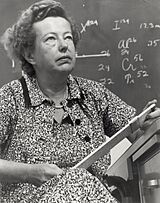

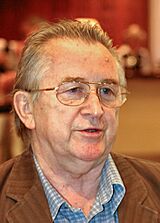
Many notable people were born or lived in Katowice, including:
- Maria Goeppert-Mayer (1906–1972): A physicist who won the Nobel Prize.
- Kazimierz Kutz (1929–2018): A famous film director and politician.
- Wojciech Kilar (1932–2013): A well-known classical and film music composer.
- Henryk Górecki (1933–2010): Another important classical composer.
- Jerzy Kukuczka (1948–1989): A famous mountain climber.
International Connections
Consulates
Katowice has 15 honorary consulates. These are offices that help citizens from other countries. They represent countries like Austria, France, Georgia, and Ukraine.
Sister Cities
Katowice is twinned with several cities around the world. These "sister cities" work together on cultural and educational projects.
- Cologne, Germany
- Groningen, Netherlands
- Košice, Slovakia
- Lviv, Ukraine
- Miskolc, Hungary
- Mobile, United States
- Opava, Czech Republic
- Ostrava, Czech Republic
- Pula, Croatia
- Saint-Étienne, France
- Shenyang, China
Images for kids
See also
 In Spanish: Katowice para niños
In Spanish: Katowice para niños












